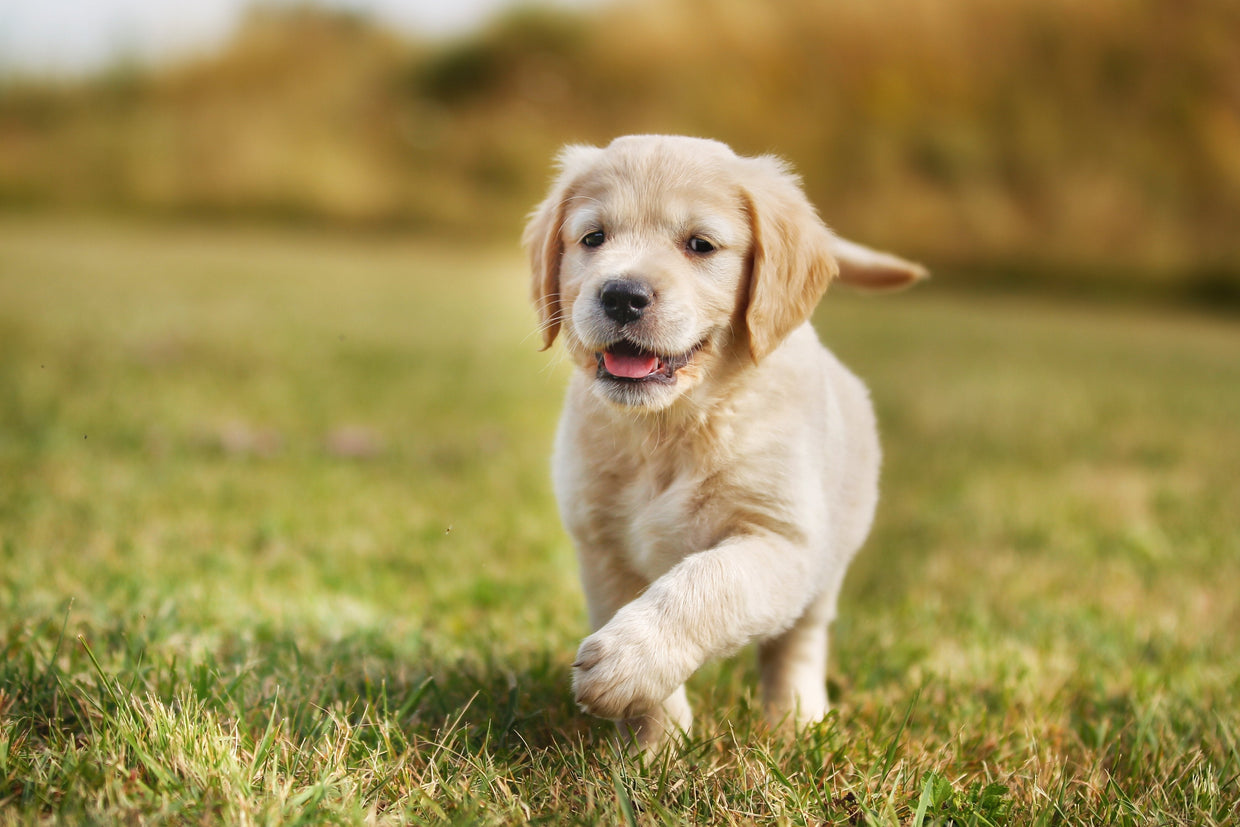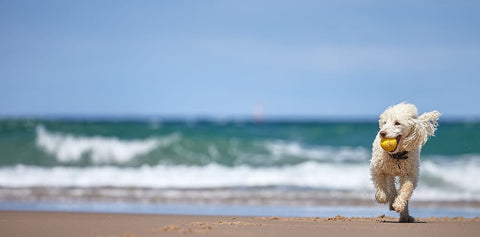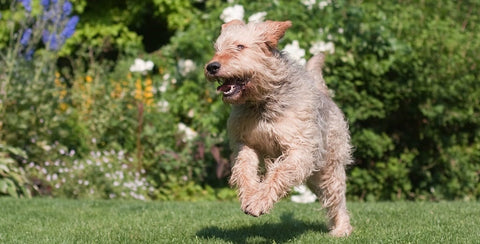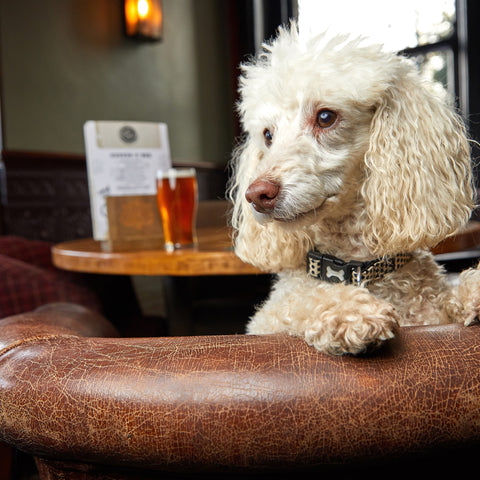

Top Puppy Walking Tips
Bringing a new puppy home and wondering how you should approach your first walks together? Read our puppy walking tips for everything you need to know.
When it comes to nurturing a happy, healthy adult, what happens in puppyhood really matters. It’s important to take care of your puppy’s physical and mental wellbeing, safeguarding both their growing bodies and their emerging personalities - puppy supplements can help. And a big part of that is the first few walks that you enjoy together. Here are our ten top tips to help you on your first puppy walking expeditions.
1) Ensure your puppy has completed their vaccinations before walking
This is less of a top tip, and more of an important reminder! As soon as you bring your puppy home from your rescue centre or breeder, you should pop to the vets for a check-up and to get their immunisations underway.
Puppies are usually vaccinated against parvovirus, distemper, leptospirosis and adenovirus 1 and 2. Your puppy’s initial vaccinations usually cost between £30 and £60, but these ‘jabs’ are vital – all of these diseases are potentially fatal, and very expensive to treat if your new best friend becomes poorly.
If your pup will spend time with other dogs – in kennels or at doggy day-care – consider kennel cough and canine parainfluenza immunisation. If you’ll take your young dog abroad, you’ll need to vaccinate against rabies too.
However, before your puppy’s vaccinations are complete, you can still use your garden for toileting and to begin collar/harness and lead walking.

2) Start socialising your puppy early
Before you begin your puppy walks, your pup can start experiencing the world by being carried around with you in a bag. This is important as puppies are most open to new experiences and learning new things between 4-12 weeks of age. This will help your puppy to be confident when you eventually start walking.
Be careful not to over-stimulate or overwhelm your puppy at first – and remember that puppy bladders are small! A couple of short trips out and about after mealtimes and subsequent toilet trips is a great way to start socialising your pup. Why not take your puppy to the shops, to a cafe or pub, for a short bus ride, or to visit friends and family? This is the start of a process that’s called socialisation and habituation.
Young dogs – just like human babies – need to learn about the world around them. It’s important to carefully shape their experiences so they are introduced to all the things that we take for granted that might be a bit scary or intimidating to a young pup.

3) Get puppy lead-training!
You may think that walking on a lead comes naturally, but unfortunately that’s not quite the case! Lead-training your puppy is an important step and doing some preparation can help make that first walk be a little less daunting for a young puppy.
Collars and leads feel strange to puppies, so introduce your pup gradually, well in advance of first walkies. Start with the collar. Buy a small, light collar (or harness if you prefer) and pop it on whilst feeding treats. Take it off again. Repeat until your puppy runs up when the collar or harness comes out – this may take a couple of days but be patient.
Then add a short piece of string, ribbon or wool (about 20 cm) where you would attach the lead. Let your pup run around and get used to the sensation. Next, add a longer piece of string, and encourage them to come to you with a treat or toy whilst giving a very gentle tug on the string. Feed the treat and follow them as they explore your home or garden. If they stop, you stop too, and encourage them with a treat to start moving again. Then swap for their first lead. Now you can even start training your dog ‘heel’ or ‘stay close’ if you want to. Just keep the training sessions fun and positive, so they see the lead and collar or harness as the start of good things!
4) Puppy walking at puppy’s pace

Go somewhere quiet and let your puppy take its time, albeit time consuming. Some puppies will be super-excited to discover the world, while others will be less outgoing. Let your puppy guide the speed and let them stop, sniff and explore.
Provide lots of positive encouragement and reassurance, and if they become overwhelmed, pause for a cuddle and some reassurance, then head home. Walkies is a kind of socialisation, so remember to make it fun with treats and play, and stop if your puppy seems stressed. Keep it short and sweet – make sure it’s an enjoyable experience that your puppy wants to repeat!
It’s also really important to be a responsible dog owner from day one, and pack your ‘walkies essentials’: treats to reward your puppy, poo bags, a phone for emergencies, and a bottle of water.
5) Don’t walk too far!
After waiting so long to be able to go puppy walking, the temptation is always going to be getting out and about as much as possible. However, it’s important to remember that your puppy needs to build up slowly to proper walks to protect its growing joints and avoid causing damage later in life.
It’s best to ask your vet their recommendations on walking your dog at your immunisation consultation – it varies from breed to breed – but broadly speaking, the Kennel Club’s guidelines are a good starting point. They say:
“A good rule of thumb is a ratio of five minutes exercise per month of age (up to twice a day) until the puppy is fully grown, i.e. 15 minutes (up to twice a day) when three months old, 20 minutes when four months old etc. Once they are fully grown, they can go out for much longer.”
We’ve made a table to help with this – it can be a bit confusing! Take a look below:

6) Protect your puppy’s joints
By avoiding over-exercising, you’ll take an important precaution against damaging your puppy’s joints. What’s more, large breeds and breeds prone to joint challenges in later life should be discouraged from rough play, running up and down stairs, or jumping on and off furniture to avoid accidental injuries. This also extends to walks – keep things relaxed and not too rough-and-tumble!
You might also consider supporting them with a joint supplement once they’re on solid foods.

7) Focus on positive learning
From buses to babies to men with beards… it’s a big world out there, and your pup needs your help to make sense of it. Think about everything your pup will experience as an adult – other creatures, travel, noises, different kinds and ages of people. Then, make sure your pup experiences these things in a positive way – lots of puppy treats and play.
However, don’t over-do it – learn the secret signs of stressed dogs, and as soon as your pup seems overwhelmed, remove him or her from the situation.
When it comes to introducing younger members of the family, never leave children and dogs unsupervised and encourage little ones to only ever touch the dog or puppy with one hand. This stops children hugging dogs, which is one of the top causes of stress in child/canine interactions.

Of course, you should never shout at your puppy or use force – positive reinforcement creates happier, mentally healthier adult dogs and more trusting dog/owner relationships.
8) Meet other dogs, but stay in control
It’s important that your puppy meets other dogs out and about, but it’s equally important to make sure experiences are positive ones. Always talk to other dog owners before letting your puppy approach – not all dogs are happy to mix with others, especially if your puppy is very bouncy and playful.
Dogs wearing yellow ‘give me space’ clothes and leads should always be avoided – and it’s wise to be careful around older dogs and injured dogs. If your puppy bounds up being friendly, the other dog might feel intimidated and (quite reasonably!) growl or snap to warn them away.
9) Invest in a long line while your puppy learns recall

Letting your puppy off-lead is a big step. We’d recommend keeping control using a long line whilst you work on recall (coming back when called), but if your puppy is playing this won’t always be practical. A great alternative is finding a safe, enclosed place to play like a special dog area of the park… or hosting a puppy party in your garden!
If your puppy is off-lead in the park and won’t come back when called, run fast in the opposite direction, making excited noises. You’ll look a bit crazy, but 99% of puppies will be intrigued by the game and quickly run after you. It’s about ‘thinking dog’ and becoming more exciting than whatever they’re focused on!
10) Get help early on to tackle any problems
It’s possible that your puppy may have a negative experience when out on early walks. After all, there’s only so much we can control as dog owners. If something not-so-positive happens, depending on how scary the incident is, you might want to talk to a behaviourist to get some advice.
A little expert help before your puppy becomes fearful and reactive can be a great investment. If you do need expert help, the register of ASAB Certified Clinical Animal Behaviourists (CCABs) is a good place to start.
Now you’ve read all our tips for puppy walking it’s time for the fun bit – spending time with your new puppy and getting out and about with confidence. One of the best things about sharing your life with a dog is the adventures you go on together. From urban rambles and discovering new routes through your local areas, through to playing on the beach and getting out and about in the countryside, it’s all up for grabs!
We hope you’ve found our puppy walking tips useful and would love to hear how you’re all getting on with your new best friends. Why not let us know below, or find us on Facebook and Instagram.


